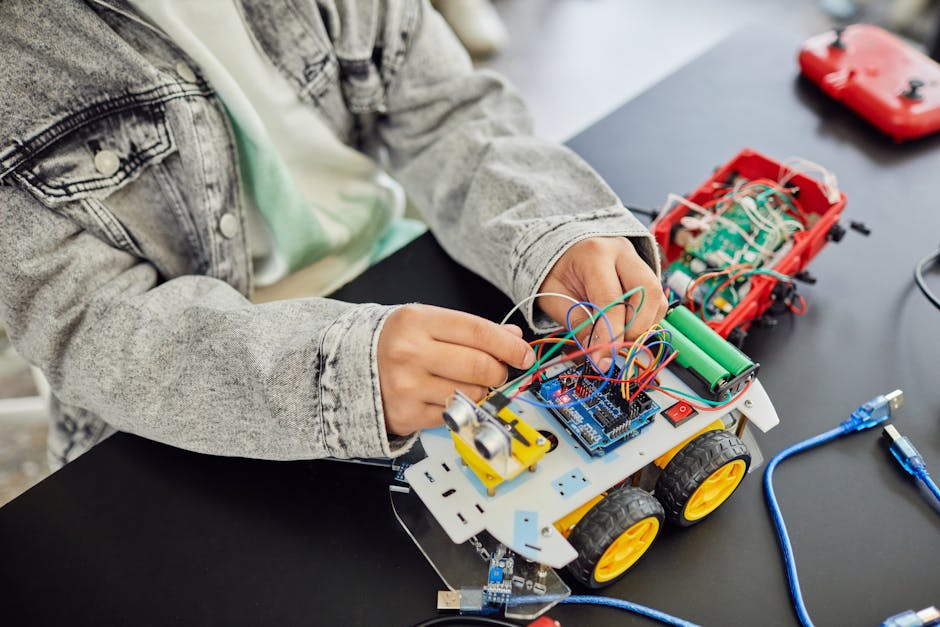Tech for Tactile Learning: Uncover Unique Gadgets for Kinesthetic Education
In today’s technology-rich world, the ways we learn and teach are continually evolving. As educators seek to engage students with diverse learning styles, tactile learning—often referred to as kinesthetic learning—has gained remarkable attention. It’s no longer enough to rely solely on textbooks and lectures. Instead, innovative gadgets are poised to revolutionize how we interact with information, actively appealing to those who thrive on movement and hands-on experience. If you’re curious about the cutting-edge tools that can enhance kinesthetic education, you’ve come to the right place!
Understanding Kinesthetic Learning in the Digital Age

Kinesthetic learning is a style where individuals prefer to engage in physical activities rather than sitting through lectures or watching demonstrations. This preference can be particularly strong in younger students, as evidenced by research indicating that movement and hands-on engagement improve retention and understanding. According to a study published in Frontiers in Psychology, integrating physical activity into learning can significantly enhance cognitive functions and student engagement.
With the rise of digital tools, educators have an unprecedented opportunity to merge technology and tactile learning. Tech gadgets that embrace this approach successfully bridge the gap between traditional educational methods and today’s digital first environment. This synergy allows for immersive and enjoyable learning experiences tailored to student needs.
Innovative Gadgets Transforming Tactile Learning

As we explore the unconventional gadgets making waves in kinesthetic education, let’s look closely at a selection of tools that turn learning into an interactive adventure.
1. Haptic Feedback Devices

Haptic feedback technology feels like something out of a sci-fi movie, but it is rooted in real-world application. By utilizing vibrations and motions, these devices offer tactile responses that can help learners connect with abstract concepts. For instance, devices with haptic feedback allow students to feel what they’re learning, whether it’s the sensation of geological layers or the vibration of sound waves.
Haptic feedback also plays a crucial role in online learning experiences. As discussed in our post on the future of haptic feedback, this technology can enhance virtual reality experiences, making them more engaging for kinesthetic learners who might struggle with traditional methods.
2. Interactive Whiteboards

Gone are the days when chalkboards ruled the classroom. Interactive whiteboards have become a staple in many modern educational environments. These advanced tools allow students to manipulate objects on screen, write notes, and interact with lessons directly. They foster collaboration, giving students the freedom to move around and explore educational content hands-on.
With the integration of various apps, educators can customize lessons to suit specific learning needs, all while keeping students engaged through physical interaction. The tactile experience of writing on a touchscreen or dragging objects into place keeps kinesthetic learners captivated.
3. Motion-Sensing Gadgets

Motion-sensing devices, like those powered by Microsoft Kinect or Leap Motion, create an interactive learning environment by allowing students to control educational content through physical movements. Imagine a science class where students simulate natural disasters or explore the solar system by gesturing with their hands. Beyond engagement, these motion-sensing tools provide instant feedback, an essential element in kinesthetic learning.
As noted in our article, sensory-sensitive technology is evolving to accommodate diverse learning profiles, ensuring that even students with sensory processing difficulties can thrive.
4. Smart Educational Toys

From STEM kits to robotics, smart educational toys are making learning playful and interactive. These toys often incorporate technology that encourages physical play, whether through coding, building, or problem-solving activities. For instance, toys like LEGO Boost allow students to build and program their creations, integrating tactile construction with computer science concepts.
Furthermore, educational toys can lead to greater motivation and retention by transforming any lesson into a game-like experience. The blend of play and learning is key, especially for students who may prefer a hands-on approach.
5. Virtual Reality (VR) Educators

Virtual Reality technology is reshaping kinesthetic education by creating entirely immersive learning environments. Students can explore ancient civilizations, dive deep into the ocean, or experience outer space—all without leaving the classroom. VR helps kinesthetic learners engage with educational content on a deeper level by allowing them to move through and interact with virtual spaces.
These platforms encourage collaboration among students, fostering teamwork as they navigate challenges together. They turn traditional lessons into unforgettable experiences.
Enhancing Engagement with AR Gadgets

With the advent of Augmented Reality (AR), tactile learning is becoming even more engaging. AR gadgets overlay digital information onto the real world, encouraging students to interact with content around them. Imagine history students walking through their school while using AR to visualize historical events occurring in their immediate surroundings. This hands-on interaction promotes greater comprehension and retention.
As discussed in our piece on augmented reality glasses, these tools are helping students visualize complex concepts, enhancing their understanding far beyond 2D learning materials.
6. DIY Learning Kits

Do-it-yourself learning kits such as those provided by companies like Osmo and Snap Circuits allow students to create tangible projects that reinforce key concepts in various subjects. By building and experimenting, students gain a hands-on understanding of mechanics, electronics, and creative problem-solving.
These kits encourage independent exploration and foster a deeper interest in STEM fields—meaning you can cultivate the next generation of innovators right in your classroom!
The Psychological Impact of Tactile Learning Tools

The integration of tactile learning tools not only enhances educational engagement but also significantly contributes to emotional well-being. Devices that promote hands-on learning experiences can reduce anxiety and boost self-esteem by providing students with a sense of achievement and mastery.
Engaging in kinesthetic learning helps students build social skills and develop teamwork abilities, primarily through collaborative group activities. As supported by studies, the benefits of physical activity on mental health are profound—moving matters, and so does playing!
For more insights into emotional intelligence and learning, check out our article on wearable tech for emotional intelligence.
Next Steps for Educators

As we stride confidently into an age where technology shapes education, it’s essential to thoughtfully integrate these unconventional gadgets into learning spaces. Here are some actionable steps educators can take:
-
Assess Learning Styles: Understand the diverse learning styles in your classroom. Identify students who would benefit from tactile learning and adapt your teaching methods accordingly.
-
Incorporate Technology Gradually: Introduce one or two new gadgets at a time, allowing both you and your students to adjust to these tools comfortably.
-
Stay Informed: Keep an eye on emerging technologies, as new innovations continue to reshape educational landscapes, enabling effective teaching strategies.
-
Collaborate with Peers: Share experiences and ideas with fellow educators. Collaborating helps you discover best practices and opens up avenues for shared resources.
-
Solicit Feedback: Engage with students about their learning experiences—what works and what doesn’t. Their insights can guide you in refining your teaching approach.
By thoughtfully integrating these tech gadgets into your educational practices, you will not only make learning more dynamic but also accessible and enjoyable for your students.
Final Thoughts
The intersection of technology and education has given rise to an exciting era where kinesthetic learning can thrive. The unconventional gadgets discussed here are making waves in classrooms, engaging students in ways that traditional methods rarely could. By enhancing tactile experiences, these tools empower learners to embrace their unique styles and succeed in their educational journeys.
As we move forward, the importance of understanding and leveraging these technologies will only grow. Embrace the future of tactile education—not only to facilitate better learning outcomes but to inspire a generation of innovative thinkers and doers.



